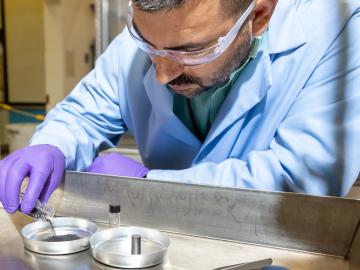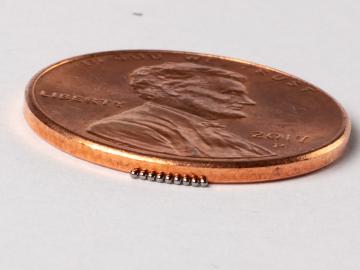
Filter News
Area of Research
- (-) Neutron Science (38)
- (-) Nuclear Science and Technology (22)
- (-) Quantum information Science (6)
- Advanced Manufacturing (3)
- Biological Systems (1)
- Biology and Environment (41)
- Building Technologies (1)
- Computational Biology (2)
- Computational Engineering (3)
- Computer Science (15)
- Electricity and Smart Grid (1)
- Energy Science (42)
- Functional Materials for Energy (1)
- Fusion and Fission (11)
- Fusion Energy (8)
- Isotope Development and Production (1)
- Isotopes (28)
- Materials (61)
- Materials for Computing (9)
- Mathematics (1)
- National Security (22)
- Nuclear Systems Modeling, Simulation and Validation (1)
- Supercomputing (125)
News Topics
- (-) Advanced Reactors (11)
- (-) Biomedical (16)
- (-) Computer Science (21)
- (-) Frontier (1)
- (-) Isotopes (5)
- (-) Physics (11)
- (-) Space Exploration (8)
- 3-D Printing/Advanced Manufacturing (10)
- Artificial Intelligence (6)
- Big Data (2)
- Bioenergy (9)
- Biology (7)
- Biotechnology (1)
- Chemical Sciences (3)
- Clean Water (2)
- Composites (1)
- Coronavirus (11)
- Cybersecurity (4)
- Energy Storage (6)
- Environment (8)
- Fossil Energy (1)
- Fusion (9)
- Grid (1)
- High-Performance Computing (2)
- Hydropower (1)
- Machine Learning (3)
- Materials (14)
- Materials Science (26)
- Mathematics (1)
- Microscopy (5)
- Molten Salt (4)
- Nanotechnology (11)
- National Security (2)
- Neutron Science (122)
- Nuclear Energy (38)
- Polymers (1)
- Quantum Computing (1)
- Quantum Science (16)
- Security (2)
- Summit (6)
- Transportation (5)
Media Contacts

Biological membranes, such as the “walls” of most types of living cells, primarily consist of a double layer of lipids, or “lipid bilayer,” that forms the structure, and a variety of embedded and attached proteins with highly specialized functions, including proteins that rapidly and selectively transport ions and molecules in and out of the cell.

An international team of researchers has discovered the hydrogen atoms in a metal hydride material are much more tightly spaced than had been predicted for decades — a feature that could possibly facilitate superconductivity at or near room temperature and pressure.

ORNL computer scientist Catherine Schuman returned to her alma mater, Harriman High School, to lead Hour of Code activities and talk to students about her job as a researcher.

As scientists study approaches to best sustain a fusion reactor, a team led by Oak Ridge National Laboratory investigated injecting shattered argon pellets into a super-hot plasma, when needed, to protect the reactor’s interior wall from high-energy runaway electrons.

If humankind reaches Mars this century, an Oak Ridge National Laboratory-developed experiment testing advanced materials for spacecraft may play a key role.

Three researchers at Oak Ridge National Laboratory will lead or participate in collaborative research projects aimed at harnessing the power of quantum mechanics to advance a range of technologies including computing, fiber optics and network

Ask Tyler Gerczak to find a negative in working at the Department of Energy’s Oak Ridge National Laboratory, and his only complaint is the summer weather. It is not as forgiving as the summers in Pulaski, Wisconsin, his hometown.

Scientists at Oak Ridge National Laboratory studying quantum communications have discovered a more practical way to share secret messages among three parties, which could ultimately lead to better cybersecurity for the electric grid

Oak Ridge National Laboratory physicists studying quantum sensing, which could impact a wide range of potential applications from airport security scanning to gravitational wave measurements, have outlined in ACS Photonics the dramatic advances in the field.

For the first time, Oak Ridge National Laboratory has completed testing of nuclear fuels using MiniFuel, an irradiation vehicle that allows for rapid experimentation.


